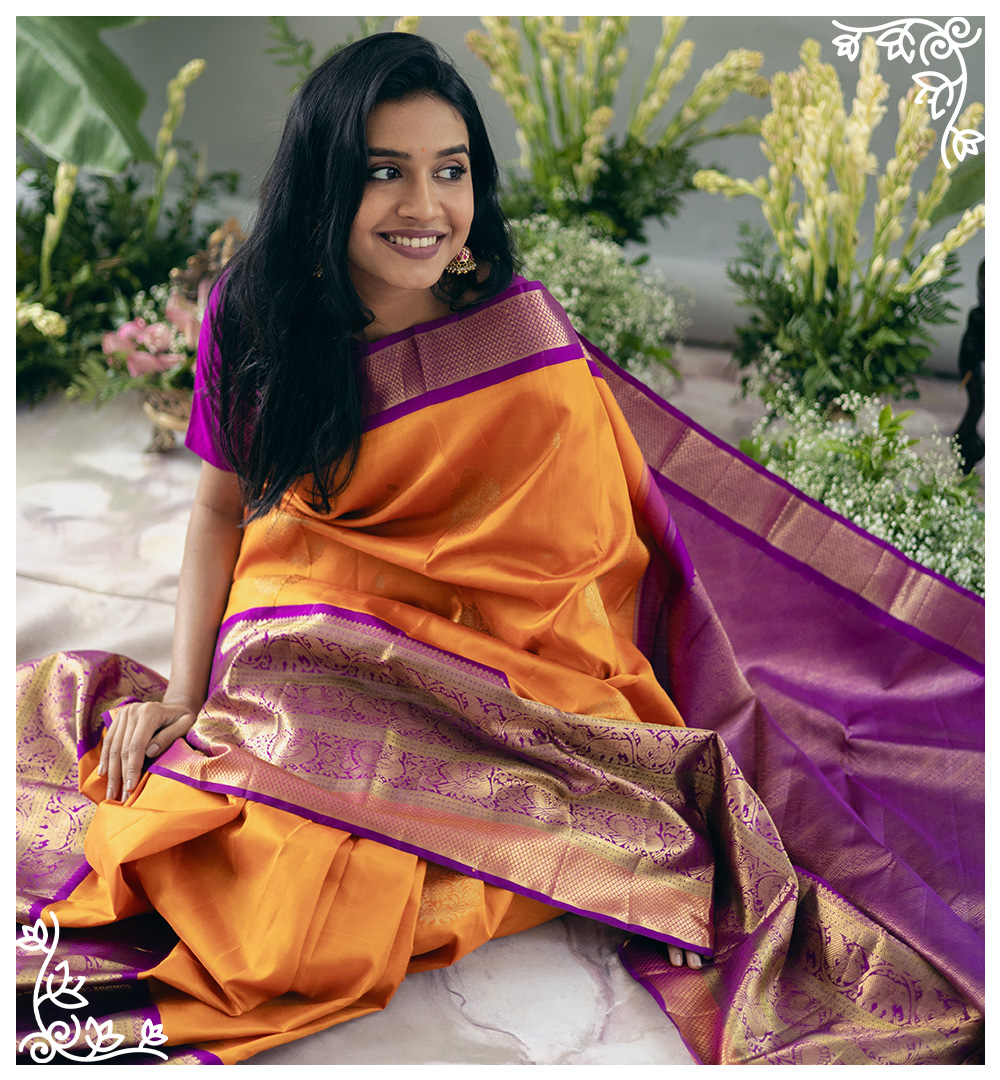The Gorgeous Interplay Between Traditional and Contemporary Kanchipurams
Why Kanchipurams are Hugely Popular
Kanchipuram Silk Sarees are the pride and treasure of the eponymous town of Kanchipuram, a beautiful town renowned for its colossal temples and splendid silks. Hailed as the ‘City of Silk’ and the ‘City of Thousand Temples,’ Kanchipuram is a very ancient city, featured even in Sangam literature as early as 1st Century AD. Every lane or avenue in the city is lined with quaint, modest houses clanging with the sound of traditional hand-operated looms for the weaving of the Kanchipuram silk sarees. They are immensely popular because of the unique sheen of the silk, the sturdy nature of the weave, the ravishing colours they come in, and the durability factor. And not to forget the mammoth charm, loveliness, and royal aura they cast on the wearer.
Traditional Kanchipuram - Ritih`
Traditional women’s attire in South India comprises a Kanchipuram golden zari saree, haaram as a neckpiece, jhumkas for the ears, kangans in the arms, a fragrant jasmine strand pinned to the braid, and a vermillion tilak on the forehead. Traditional Kanchipurams are classics in bright colours with contrasting borders and Mundhanis laced with sparkling golden zari in a double pettu design. There are also other scintillating patterns like the Paalum Pazhamum (checks), Mubbagam (three parts), Vaira Oosi (a splattering of zari throughout), and plain solid colours with broad zari borders. Wearing a Kanchipuram is like putting on the garb of history, artistry, culture, and tradition decorated with the lustrous, speckled band of golden zari and motifs that are representative of life in ancient India with its flora, fauna, festivals, features et al.
Contemporary Kanchipurams - Kriya
Kanchipuram sarees today come as an enticing blend of tradition and modern aesthetics. A broad spectrum of light, pastel, and new shades have been added to the existing solid band of colours that are bold and bright. Designs from silk sarees of other states have easily glided into the Kanchipuram design catalogue; so now we have brocaded zari motifs, Kalamkari designs, Warli patterns, Kerala mural motifs, and Kantha embroidery work on pure Kanchipuram silks. This diversification has added to the richness and versatility of the sarees, in addition to making them suitable for everyday wear; say a heavily brocaded Kanchi silk can be worn as bridal wear, whereas a soft silk embroidered saree goes well for casual wear.

Styling and Occasions
There is undoubtedly a ring of regality haloing the Kanchipuram saree, so accessorising with gold would be the way to go. Chunky filigreed jhumkas, intricately worked chokers, Haarams (Kasu Malais, Mullai Mottu Malais, Mangai Malais), Addigais, Maang Tikkas, and heavy bangles fit the bill to a T. An ornate clutch or Potli bag completes this classic look. Alternatively, lightweight, borderless zari-less Kanchipuram silk sarees are perfect to be worn as casual wear, say to an evening outing, a temple visit, a boardroom presentation, or to the cinemas. And for this, we can get very creative with accessorizing – chunky beads, oxidised silver jewellery, fashion jewellery, and whatnot. Different styles of draping and pairing with different kinds of blouses also present us with umpteen styling options.
Closing Off
Tulsi Madras’s ‘Kriya’ collection is a curated bouquet of Kanchipuram sarees that stands as a testimony to Tulsi Madras’s mastery of innovation, design, and commitment to superior quality. There is a seamless blending of tradition and modernity to bring about a wonderful union that scores high on the style meter and also enhances your personal style.
The ‘Ritih’ collection presents Tulsi Madras’s hand-crafted range of traditional kanjivaram sarees which carry authentic ancient Indian weaving standards in each warp and weft. These sarees come in the best classic colours and the most resplendent golden zari work, fitting like a glove in any bride's wedding trousseau.


